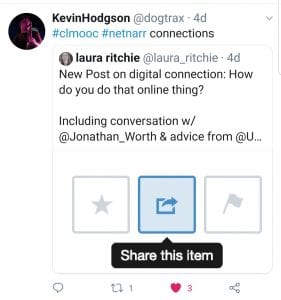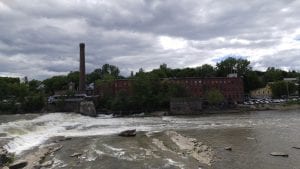Communities, connections, and storytelling
My (virtual) colleague Kevin Hodgson alerted me to this #netnarr post by Laura Ritchie, in which Laura asks and seeks to answer the question, “How do we connect with the wider community across the globe?” I was fascinated by Jonathan Worth’s responses to Laura’s questions, as he analyzes online networks and communities.
I was particularly struck by Jonathan’s statement that “everyone’s got a story, you’ve just got to enable them to tell it.” This reminded me of ethnographic research I conducted as part of the 2017 Community Works Institute. We spent one afternoon strolling through the compact Vermont town of Winooski, once home to thriving woolen mills. After the mills closed in the mid-1950s, the town saw an economic decline for two decades. In the 1980s, the mills were converted to commercial and residential spaces, which helped revitalize the town.
The most startling trivia about Winooski is that in 1980 there was serious consideration of covering the town in a geodesic dome to make winters more tolerable for the residents! I doubt I would have ever stumbled across this fascinating information without engaging in this walkabout.
As we sauntered through the town, we observed, remarked upon, and snapped photos of the various architectural styles. We loitered in the community center, seeking to understand the “vibe” and interests of the town. We entered various shops and gathered stories from the shopkeepers. We talked to people on the streets. Some were residents, some were visiting from elsewhere.
One of the questions our facilitator asked after we reconvened was, “How did you reciprocate with the people who answered your questions?” The answer was simple, and a bit of an ah-ha for me, “By listening to their stories.”
The importance of storytelling within communities is summarized in this 2017 Time magazine article. A study that was done among a hunter-gatherer population in the Philippines concluded that “‘[s]torytelling is a costly behavior… requiring an input of time and energy into practice, performance and cognitive processing.’ But the payoff for making such an effort is big: When the investigators looked at family groups within the 18 camps, they found that skilled storytellers had, on average, .53 more living children than other people.”
Everyone’s got a story, you’ve just got to enable them to tell it. ~ Jonathan Worth
We all have stories to tell. One of the best ways we can honor our students and build trust with them is by actively seeking to hear and understand their stories.


Yes I agree, its a conversation we’ve been having at length recently on the project we’re working on. How do you create fertile spaces (digital in this case) for empathetic understanding, and “perspective” is what we called it. Seeing shared content from the “perspective” of fellow learners.
And all this comes down to remembering there’s a human behind the data and they want to be valued, their values to be understood – or at least respected and – not to feel lonely either. Yes its a rich bundle to unpack isn’t it? Narrative, construction of meaning, digital intimacies – all the good stuff 🙂
Yes… the word “data” often gets my hackles up on many levels. In education, there is a bent towards everything being “data- and evidence-driven” which dehumanizes a profession that professes to want to foster learning and potential and successful futures for our students. In many ways, “data-driven” in education is no different than “data-driven” as used by Amazon.
Hello Charlene, I really enjoyed reading your post. You’re reminding me of the thing I loved about my old job. It wasn’t the photography, the picture taking was really just a passport into spaces and places I didn’t belong. And it always felt like an itch. I only ever knew I’d got a strong pic when I suddenly felt better (largely days of film pre digital insta-feedback). The really enjoyable bit was enabling someone to tell their story then looking at this thing they’d shared and working out how to re-package it. Its funny how the thing of value, be it a perspective, a fact or some such other was seldom the thing the subject found most interesting. And packaged up right for a particular audience it became such a powerful thing. So powerful you could make people do stuff/ think about or consider stuff as a result. Simon Roberts says of his photography that beauty is a seductive tool that he uses for that purpose of drawing people in and trapping them into considering his message/theme/subject.
I think you’re right about listening to people being important. There’s a pastoral role that’s deeply human in looking after someone else’s thoughts and experiences as told by them. I also think theres a duty of care to consider in terms of what we do with that story as well. Perhaps sometimes its enough to caretake but other times how does one do it justice? – is a question I’ve never really respolved to the point of feeling entirely comfortable. Thank you for indulging me anyway – hope we get to meet one day.
Thank you, Jonathan! I especially appreciate your thought, “And packaged up right for a particular audience it became such a powerful thing. So powerful you could make people do stuff/ think about or consider stuff as a result.” Isn’t that what many of us are doing in our daily lives, wanting others to “do, think, or consider” our perspective, and to value or at least acknowledge the value of the things we value? You have given me more food for thought. I, too, hope we get to meet one day!
bugger! I commented in thwe wrong place and now everythings out of sync – sorry Charlene.
No worries! This conversation is fascinating.